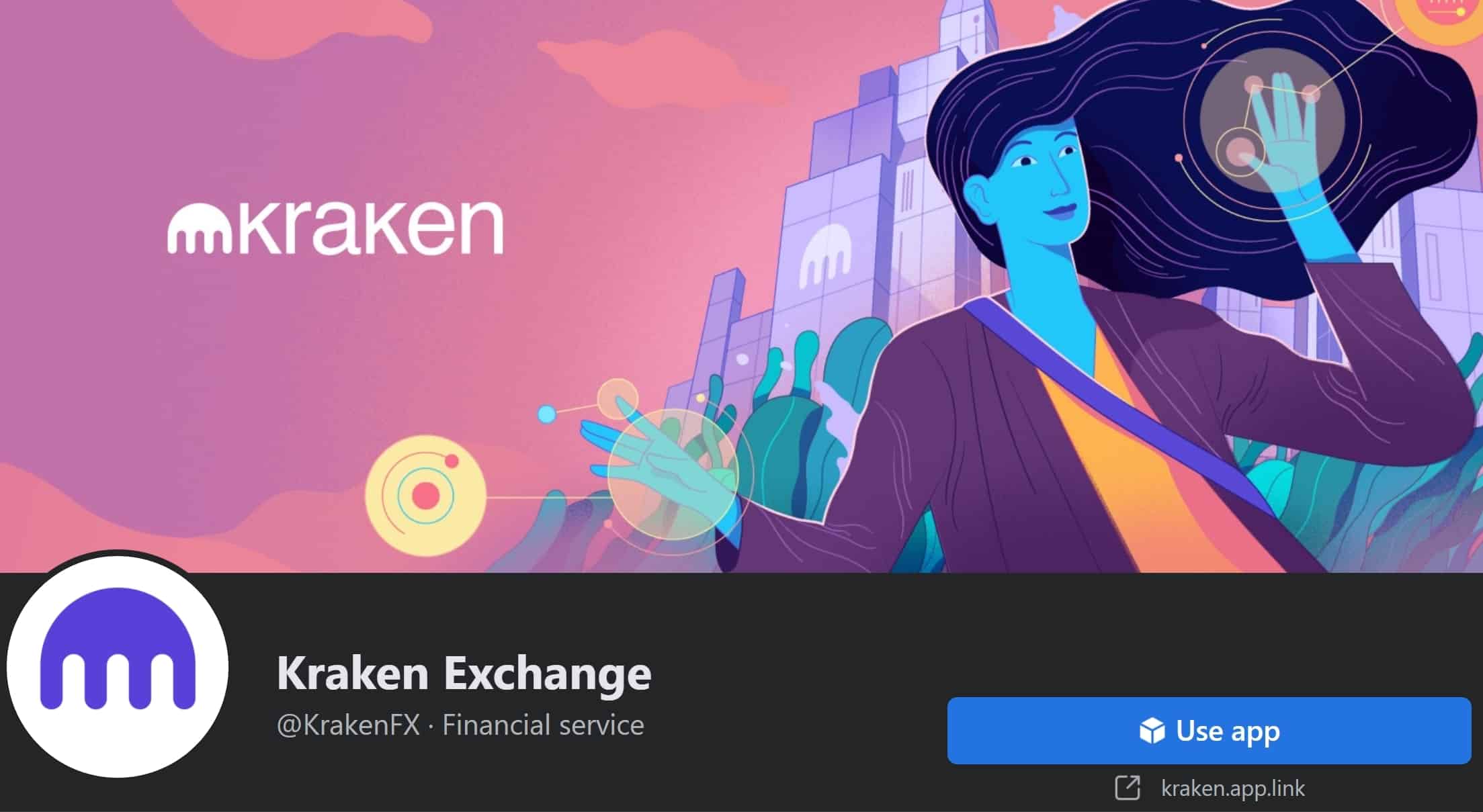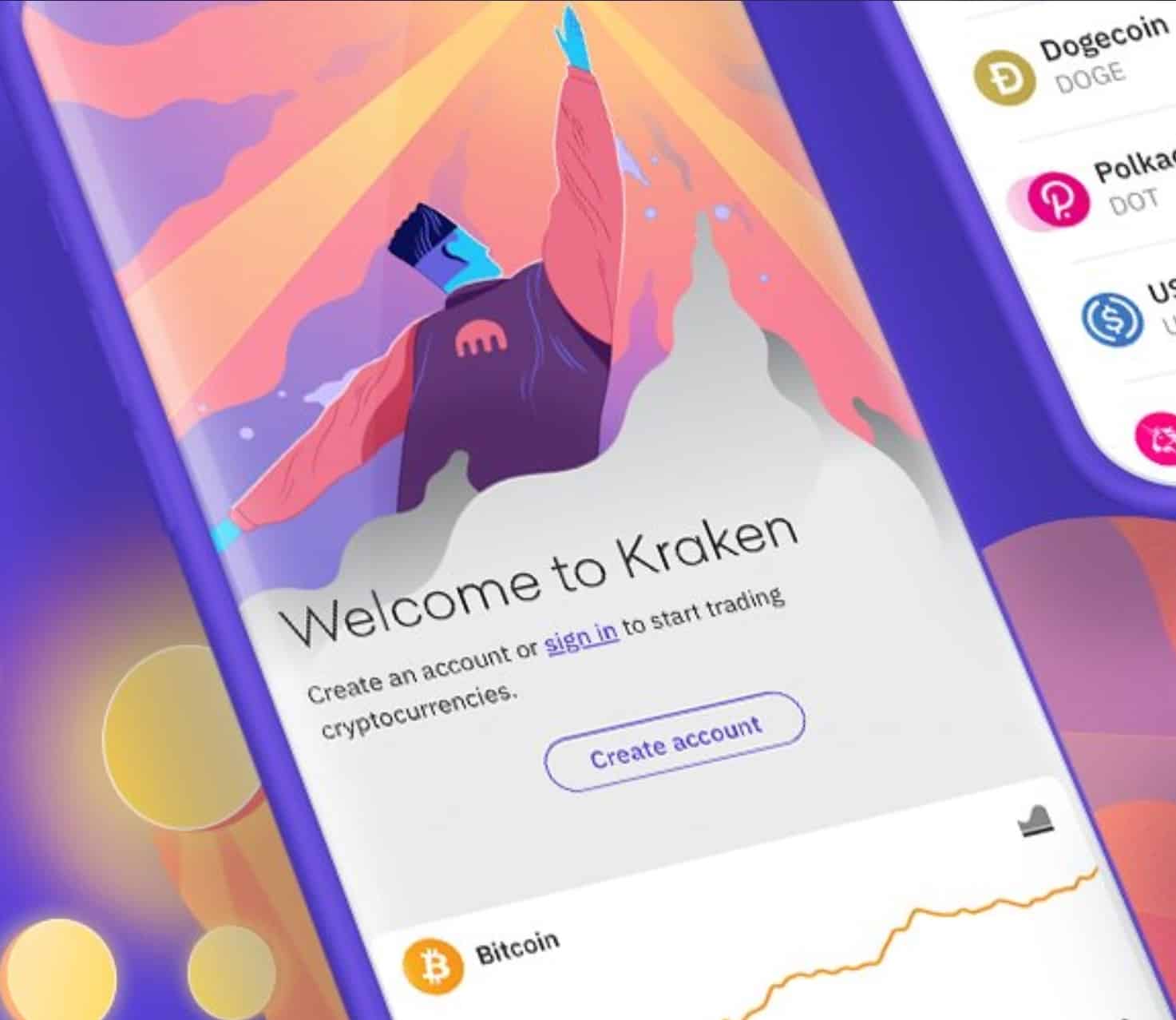
Kraken is a US-based cryptocurrency exchange and bank founded in 2011 and one of the largest and more established US exchanges on the market. It is available for residents of 48 US states and 176 countries, and lists 95 cryptocurrencies.
As of Q4 2021, Kraken averages around $2B USD in daily trading volume. All users of Kraken are required to comply with Know Your Customer (KYC) regulations in order to use the exchange and trade.
History of Kraken
Kraken was co-founded by Jesse Powell in 2011 after the Mt. Gox hack and security breach, and Jesse today still acts as the CEO of Kraken. Jesse originally began developing Kraken as a replacement in the event that Mt. Gox closed, which it did in 2014.
The Kraken exchange launched after 2 years of testing and development in 2013, initially offering only BTC, LTC, and trades in euro, later adding support for additional currencies and margin trading.
Kraken became one of the first crypto exchanges to be listed on Bloomberg Terminal in 2014, and still provides crypto market price information there. Kraken was granted a special purpose depository institutional (SDPI) charter, which is a US bank charter under federal and state law, in Wyoming in Sept 2020, becoming the first cryptocurrency exchange to hold such a charter in the US.
This charter gave Kraken the permission to become the first special purpose depository institution to provide comprehensive deposit-taking, custody, and other services for digital assets. Kraken was the first crypto exchange to pass the Proof-of-Reserves cryptographic audit.
Jesse Powell has been a longtime proponent of cryptocurrency adoption and a critic of attempts to overregulate the sector by regulatory agencies. Kraken aims to promote the launch of Kraken Bank in Cheyenne, Wyoming, which is a turning point for the integration of crypto with mainstream finance.
Kraken is best for:
- Investors and traders of all skill levels who desire the choice between both a simple and advanced platform for both spot investing and active trading with competitive fees, a moderate selection of trading pairs, good liquidity, mobile apps access, and a stellar security track record and US regulatory licensing
- Advanced US and international traders who wish to use up to 50X leverage futures trading (not available in the US) and 5X leverage margin trading, an OTC desk, and staking services
- Crypto-only traders and investors who wish to get access to the entire Kraken ecosystem and support services
PROS
- Competitive fee schedule
- Comprehensive security
- Established liquidity
- Offers spot trading, staking, margin trading, futures, and OTC
- “Dark pool” invisible order book
- Mobile and desktop versions
CONS
- No option for fee discounts
- Residents of New York State and WA cannot use it
Pros & Unique Features
The biggest perks of Kraken are its all around established cryptocurrency services offering a competitive, simple fee schedule, with comprehensive security and good liquidity. Kraken does not offer the most cryptocurrency trading pairs or the highest margin and leverage availability, but the offerings present are done well.
Kraken offers over 90 cryptocurrency market offerings and over 400 pairs, which is not as large of a selection as competitors KuCoin, Binance, or Coinbase.
For trading, Kraken offers spot trading, margin trading with up to 5X leverage, and futures trading with up to 50x leverage. Kraken also offers an OTC trade desk to execute large trades without disrupting the market, with personalized service. For advanced clients, Kraken offers an extra layer of dedicated, one-on-one support with a Kraken Account Management service. For advanced traders, there is also a dark pool offering available with an invisible order book so other parties do not know one’s orders.
Beginner traders and investors can make use of the Instant Buy platform which has the highest fees out of all other trading options at Kraken, but makes buying and selling crypto with payment cards extremely easy.
Other products offered include Indices that offer pricing data powered by aggregated trade data from several exchanges. An API is also offered for trading bots. Kraken also acquired the company and service called CryptoWatch that helps traders keep tabs on the market conditions. Staking services are offered as well for several assets at rates from 1-18% APY.
Kraken also offers an easy-to-use online trading interface and 3 separate mobile apps with full buy and sell functionality suited for beginner traders or buy-and-hold investors. A simple app interface allows investors to buy crypto with ACH and payment cards, monitor prices, and purchase predefined amounts. The Kraken Pro app allows users to have a professional trading experience comparable to the web interface, with advanced order types, margin trading access, and advanced charting. The Kraken Futures mobile app allows mobile futures trading.
As for customer support, Kraken Support offers 24/7 contact through their website, email, a ticketing system, the mobile app, and other channels.
Cons & Disadvantages
The main disadvantage of Kraken is its relative lack of extensive crypto financial services and products as compared to the ecosystem of other competitors such as Binance, KuCoin, and Crypto.com.
Kraken also has a lower amount of cryptocurrency coin and trading pairs offered than the noted competitors, however its fee schedule is on the more competitive side, with fees for the highest volume tiers trending to 0, though there is no option for fee discounts with staking/buying a native coin or rebates for maker fees.
Since Kraken is a US based exchange, all users are required to complete KYC identity verification and the basic starter tier account limits are very limited in functionality, but users can opt for higher verification levels that require some waiting period to verify. Residents of New York state and WA cannot use Kraken and funding options for US customers in general are slightly more limited than for international users. US users cannot trade Kraken Futures. Margin trading is available for US users that meet specific requirements.
Though some US investors may prefer the peace of mind and lack of regulatory risk that comes with using a licensed and regulated US exchange, users who wish to transact without KYC may opt to use competitors like KuCoin or FTX.
Kraken Fees
Kraken uses the common maker-taker model to assign the fee schedule with volume-based incentives based on the user’s trailing 30-day trading volume. Volume generated by Instant Buy (which has higher fees than Kraken Pro) does not count toward the user’s 30 day volume incentives.
Taker fees are charged on market orders that are filled immediately (takers of liquidity from the market), and maker fees are charged on orders that are not filled immediately but rather are placed in the orderbook as limit orders (adding to the market liquidity).
Market orders are always charged taker fees since they take volume from the orderbook, while limit orders are always charged maker fees since they add liquidity and volume to the orderbook. If an order goes on the order book partially or fully (a maker order), any subsequent trades coming from that order will be as a “maker.”
Kraken’s trading fees are determined based on a user’s trading volume over a 30-day period (in USD).
The table below shows the tiered fee structure for Kraken Pro, the exchange, and is designed so volume-based discounts are attainable for investors of all sizes.
The fee schedule for Futures Trading is separate, fluctuates with the addition of real-time market funding rates, and may be found here for USD-collateralized futures. The fees for FX pairs such as EUR/USD follow a different fee schedule that can be found here.
The fees for margin are applied in addition to trading fees at the opening and closing of margin positions. US accounts are limited to a 28-day maximum term for maintaining opening margin positions, while those outside the US are limited to a 365-day term. Max leverage available for each pair ranges from 2x-5x and can be found here.
The fees for Instant Buy, for the user to instantly buy, sell, or convert Bitcoin or other cryptocurrencies on Kraken.com or via the Kraken App are charged at a standard 0.9% fee for any stablecoins (USDT, DAI, USDC) purchased with USD or with another stablecoin and 1.5% fee for any other crypto or FX pair.
Kraken Pro Spot Trading Fees Based on Trading Volume (30-Day Period)
|
30-Day Volume (USD) |
Maker Fee |
Taker Fee |
|---|---|---|
|
$0-$50K |
0.16% |
0.26% |
|
$50K-$100K |
0.14% |
0.24% |
|
$100K-$250K |
0.12% |
0.22% |
|
$250K-$500K |
0.10% |
0.20% |
|
$500K-$1M |
0.08% |
0.18% |
|
$1M-$2.5M |
0.06% |
0.16% |
|
$2.5M-5M |
0.04% |
0.14% |
|
$5M-$10M |
0.02% |
0.12% |
|
$10M+ |
0.00% |
0.10% |
|
|
Other Fees
Kraken offers a wide range of funding options with low fees for USD, EUR, CAD, JPY, GBP, CHF, and AUD.
Kraken charges the following deposit and withdrawal fees:
- No deposit fees on most crypto assets but note that the blockchain network the user is transacting in will charge fees. Some newer assets such as Augur (REP) and Gnosis (GNO) include deposit and wallet setup fees but are minor.
- Withdrawal fees for crypto assets require a small flat rate paid to cover the transaction cost and these fees are determined by the blockchain network and can fluctuate at any time. Minimum withdrawal amounts and fees can be found here.
- There is a 3.75% payment card processing fee and digital wallet payments processing fee, plus a $0.25 surcharge, in addition to the Kraken fee. The fee for online banking or ACH processing is 0.5%.
- Depositing funds with CAD and EUR SEPA is free. SEPA EUR withdrawals cost 35 EUR. Withdrawals in other fiat currencies differ and can be found here.
- Withdrawing USD fiat with a standard wire costs 5 USD per transaction, and a global SWIFT transfer costs 35 USD.
There are no fees for signing up or for having an inactive Kraken account, nor any fees for holding funds in a Kraken account, and users may hold assets as long as desired.
Account Tiers & Limits
Kraken requires KYC identity verification for all users, and has 4 levels of account verification: Starter, Express, Intermediate, and Pro.
All four verification levels have access to unlimited crypto deposits (except for Express), but withdrawal limits differ. Fiat deposits and fiat withdrawals also differ. Margin trading and futures trading access also differs as well as access to OTC trade desk services and the amount of API keys granted.
Starter level verification takes up to 1 hour, while the higher 2 levels can take between 1-5 days for verification.
Starter
- Unlimited crypto deposits
- Low crypto withdrawal limits
- No fiat deposits allowed
- No fiat withdrawals allowed
- Low margin trading limits
- No Kraken Futures, OTC desk, corporate account access
- 16 API keys granted
Express
- Crypto deposits and withdrawals are not unlimited
- $9K USD lifetime limit for cash deposits
- $9K USD lifetime limit for cash withdrawals
- 16 API keys granted
Intermediate
- Unlimited crypto deposits
- High crypto withdrawal limits
- High fiat deposit limits
- High fiat withdrawal limits
- Higher margin trading limits
- Access to Kraken Futures, no access to OTC desk, corporate account access
- 16 API keys granted
Pro
- Unlimited crypto deposits
- Highest limits for crypto withdrawal limits
- Highest limits for fiat deposit limits
- Highest fiat withdrawal limits
- Highest margin trading limits
- Access to Kraken Futures, OTC desk, corporate accounts
- 25 API keys granted
Crypto Security
Kraken offers top-notch, industry leading security with full reserves, banking relationships, and high compliance and legal standards. Kraken ranks second in cybersecurity rankings with the third-party exchange security review site CER, behind crypto.com. Most notably, Kraken is one of the few exchanges that has never had any major hacking incidents.
Kraken offers safe coin storage, with 95% of deposits being held offline in air-gapped, geographically distributed cold storage units spread across the world. The servers are kept in secure cages under 24/7 surveillance by armed guards and video monitors. All sensitive customer contact information at the system and data level is encrypted and the exchange conducts regular vulnerability and penetration testing of its systems by Kraken Security Labs, a team of security researchers dedicated to protecting the ecosystem.
Reserves are kept full so customers can always withdraw immediately on demand.

Security features offered include 2-FA verification using Yubikey and Authenticator, email confirmations for withdrawals with self-serve account locks, customizable, granular API key permissions with range boundaries, encrypted email communication, 24/7 live chat and email support, zero settlement risk with no chargeback fraud, configurable account timeouts, address whitelisting, device management, and more.
Kraken Review Conclusion
Kraken is a great choice of exchange for beginner to experienced investors and traders who desire access to a moderate selection of cryptocurrency trading products and pairs, margin trading at up to 5X leverage, futures trading at up to 50X leverage for non-US traders, and users who value security, liquidity, and competitive trading fees with US regulatory licensing and a solid brand reputation.
- With a tiered fee schedule based on 30-day USD trading volume, Kraken’s trading fees compete favorably with other competitors such as Binance, Coinbase, and FTX, while offering a moderate selection of cryptocurrency trading products that is much smaller than that of Binance or KuCoin but larger than that of Binance US or FTX US.
- Investors and traders of all skill levels who desire the choice between both a simple and high-performance advanced platform and mobile apps for both spot investing and active trading with competitive fees.
- Advanced traders who wish to use up to 50X leverage futures trading (non-US traders only), 5X leverage margin trading, from an exchange that has a US regulatory banking charter and a stellar security track record.
- Crypto-only traders and investors who wish to get access to the entire Kraken brand’s suite of products including staking services, API, OTC desk, account management services for certain clients, and more.
Other Alternatives
For customers who desire access to a more simple user interface for buy-and-hold functionality, or those who do not desire to participate in cryptocurrency futures or margin trading, Coinbase and Gemini make a great alternative with Coinbase offering a slightly larger and more competitive amount of cryptocurrencies to trade, and with Gemini’s selection being smaller and more limited.
Beginners, buy-and-hold investors, and low volume traders may prefer the easy to use features and functionality of Coinbase with its brand presence, similar status of US regulatory approval, and cryptocurrency education that even provides the chance to earn free cryptocurrency for learning.
Coinbase is best designed for casual to intermediate cryptocurrency users and also had a moderate selection of cryptocurrencies offered at a very similar amount to Kraken – while active traders who need access to order books and advanced charting functionality will prefer using Coinbase Pro, FTX, Binance, or KuCoin, although their fee structures differ significantly and Kraken’s fees are competitive with all of these.
For customers who desire to trade and invest in stocks in addition to top cryptocurrencies and do not mind having a smaller selection from which to choose or only desire access to the top 20 cryptos on the market, Webull and Robinhood are brokers that offers US equities and a small selection of cryptocurrencies.
Other competitors to Kraken include Crypto.com, Voyager, and eToro.
Kraken vs Coinbase
The main advantage Kraken offers over Coinbase is its lower fee schedule as compared to Coinbase’s high fees, whose fees start at 0.5% for both markers and takers for the lowest fee tier, while those of Kraken start at 0.16% for makers and 0.26% for takers, and trends to 0 for makers are higher levels of volume, is much more simple to understand as compared to the fee schedule Coinbase uses.
Both exchanges offer the option of advanced charting and crypto-to-crypto trading pairs using Coinbase’s Coinbase Pro product. Coinbase Pro does not offer margin trading any longer, while Kraken offers 5X leverage margin spot trading for certain US investors, and margin futures trading with up to 50X leverage only for international, non-US users.
Coinbase is a public US company and offers transparency into its industry-leading security along with its brand reputation, while Kraken is a top 5 crypto exchange by daily trade volume, as well as a regulated US exchange, and has a banking charter with no known large scale hacks in the past.
Ultimately, advanced users who desire similar competitive fees to what Kraken offers but less than Coinbase or Coinbase Pro offer will find the choices below equally valuable.
Kraken vs FTX
Kraken and FTX are some of the most competitive options for low trading fees. Both exchanges utilize a similar fee structure, with FTX’s based on 30-day USD trading volume, the same with Kraken’s is. FTX offers fee reductions if paying fees using their native token, FTT, in the amount of anywhere from a 3-60% fee reduction with holding varying amounts of FTT, while Kraken has no such feature.
FTX cannot be used by US persons, and instead offers a US version of its exchange whose trade offerings are much more limited than its parent global exchange, offering only 24 coins ad 53 pairs, which is significantly smaller than Kraken’s offerings. Both offer OTC portals for larger traders and advanced trading and charting platforms for advanced traders.
Kraken offers 90+ coins and 400+ trading pairs which is a more broad selection than FTX US but not as broad of a selection as FTX which offers 307 coins and 472 trading pairs.
Kraken vs Gemini
Kraken is a better choice than Gemini if considering trading fees and cryptocurrency market selections and trading pairs. The minimum fee tier at Gemini starts at 0.35% for takers and 0.1% for makers, with a flat transaction fee between $0.99-$2.99 and 1.49% transaction fee for trades over $200.
Kraken, in contrast, starts at 0.16% for makers and 0.26% for takers, with no flat transaction fees unless using the Instant Buy feature.
Both Kraken and Gemini offer staking or lending services that allow users to earn interest on their holdings. Note that US persons are allowed to use both Gemini exchange which is based in and regulated in the USA and Kraken exchange which is also based in and regulated in the USA.
In comparison to Kraken’s large selection of coins and trading pairs, Gemini only offers 62 coins and 86 trading pairs which is substantially lower, so traders outside of the US looking for a large selection of coins, and margin and futures trading, will prefer to use KuCoin or another option like Binance or FTX.
Kraken vs KuCoin
Kraken offers margin trading at up to 5X leverage which is less than KuCoin’s 10X leverage offering.
Kraken also uses a maker-taker fee schedule, starting at 0.16% maker fees and 0.26% taker fees at the entry level which is not as competitive as the fee schedule for KuCoin, even before taking into account the fee reductions offered by KuCoin. Kraken does not have provisions for free reductions, while KuCoin offers a flat 20% fee reduction from holding its native token KCS.
Kraken offers a moderate variety of cryptocurrencies and pairs (93 coins, over 400 pairs), so users who value a large selection and advanced traders who seek margin may enjoy using Kraken but sacrifice the possibility of slightly more competitive fees and a much larger selection of cryptocurrency coins and trading pairs that KuCoin offers (562 coins and 1095 trading pairs), but most notably, users will value the selection of rare and hard-to-find low market cap. cryptocurrencies for which KuCoin is known.
Kraken is accessible in 48 US states and is regulated and licensed by FinCEN in the USA, while KuCoin is not regulated nor licensed in the USA, but US customers are not barred on KuCoin’s end from using its services.
Kraken vs Binance
Binance is the leading global crypto established exchange by trading volume, offering a much larger selection of cryptocurrencies – over 351 coins and over 1300 pairs, which is the second most extensive selection on this list, behind KuCoin. Binance also offers a more extensive list of cryptocurrency financial services and products.
Both the Binance and the Kraken brands are well-known and respected in the industry, both offer an array of products with Binance’s being more extensive in DeFi as well, both options offer support and great liquidity, but Binance may win in the liquidity department because it is the highest volume exchange by a large margin, while Kraken is #5 as of Q4 2021. Hence, advanced traders moving large transaction volumes for whom liquidity may be a concern may prefer Binance, but for smaller or intermediate traders, this will not be a concern as Kraken’s volume and liquidity is enough to support the average person’s activity.
Kraken also offers access to as much as 50X leverage on futures pairs, while Binance lowered their maximum leverage offering to 20X in 2021. Kraken also offers margin (up to 5X leverage) in the USA for qualified individuals, while Binance exchange is not at all accessible to US persons and US customers will have to use Binance US which is a much more limited version of its global parent site, with only 64 coins and 130 pairs, making it less competitive overall than Kraken. However, it is regulated in the US and US persons can perform KYC without an issue. US persons can perform KYC on Kraken’s US regulated exchange without a problem.
Kraken’s minimum fee tiers start at higher percentages for both makers and takers, while Binance starts lower at 0.1% for makers at 0.1% for takers and additionally offers fee reductions for -25% off fees paid in BNB, while Kraken has no such functionality, so overall Binance wins in the fee department.
Binance’s network of products is more extensive at this moment, with offerings such as crypto-collateralized loans, its own smart contracts platforms for access to DeFi with Ethereum compatibility and very low fees, while Kraken focuses only on staking services, mobile apps, margin, and futures trading, all of which Binance also offers at a well-developed level.
In summary, advanced traders and intermediate users alike who value a large selection of cryptocurrencies, products like staking, lending, and more, competitive fee structures, and futures and margin products will value both exchange offerings but may lean towards Binance for the edge in products and lower fees, or towards Kraken if they prefer to use a US regulated and licensed exchange.
Kraken User Reviews
- Redditors in the r/CryptoCurrency subreddit compare Kraken to other centralized exchanges. One user comments that “Kraken is the first US Exchange I know of to file as a bank,” which is obviously a unique feature some may be in support of. The same user goes on to lay out a very good comparative response. Others emphasize Kraken’s superior security, “the best customer support of any exchange”, and cheap fees on the pro platform.
- When asked if Kraken is the best exchange to use in 2022, u/Mallardshead replies: “Their customer service certainly is, but you shouldn’t be using a CEX to begin with.” The other commenters seem to agree that it is good, but one states their account was locked and Kraken “wouldn’t let us transfer BTC to a wallet”.
- SHIBArmy users rallied against Kraken when the exchange supposedly posted on social media that they would list the SHIB token but then did not.
- When asked if “Kraken [is] the best place to buy Bitcoin?”, users on the Bitcoin subreddit seem to think so.

